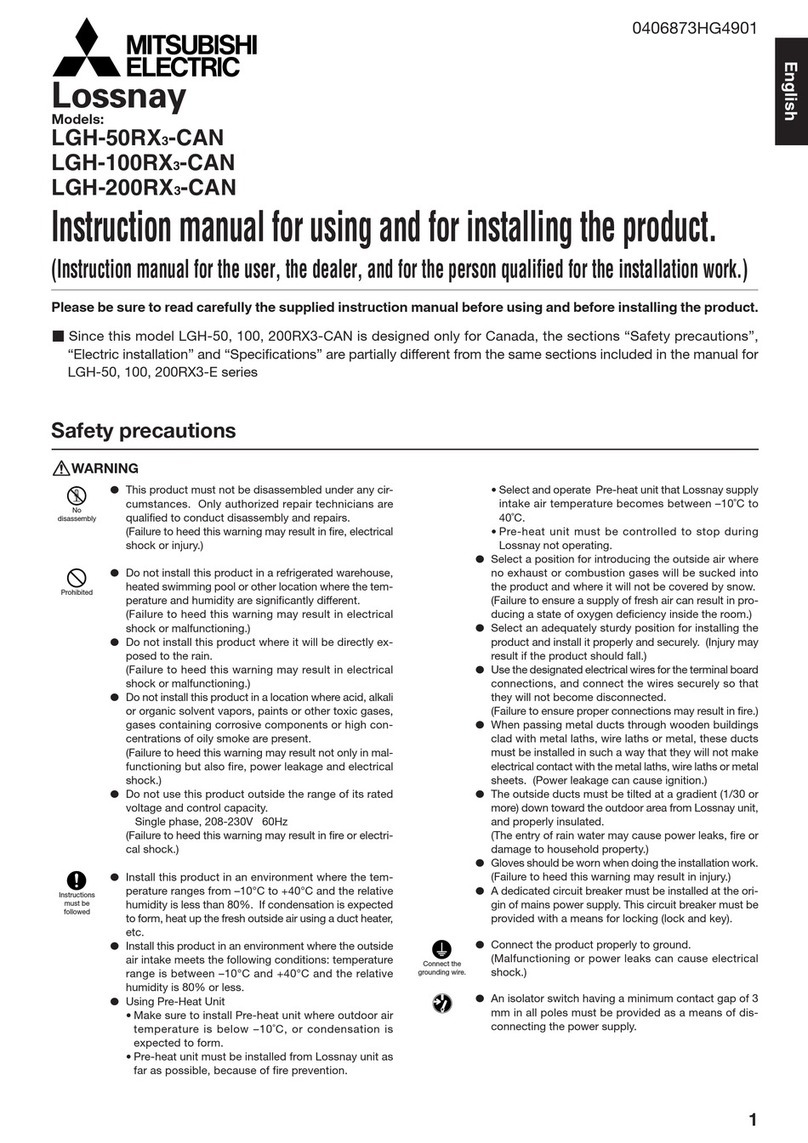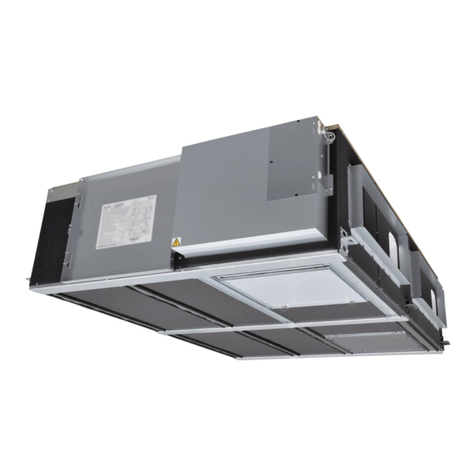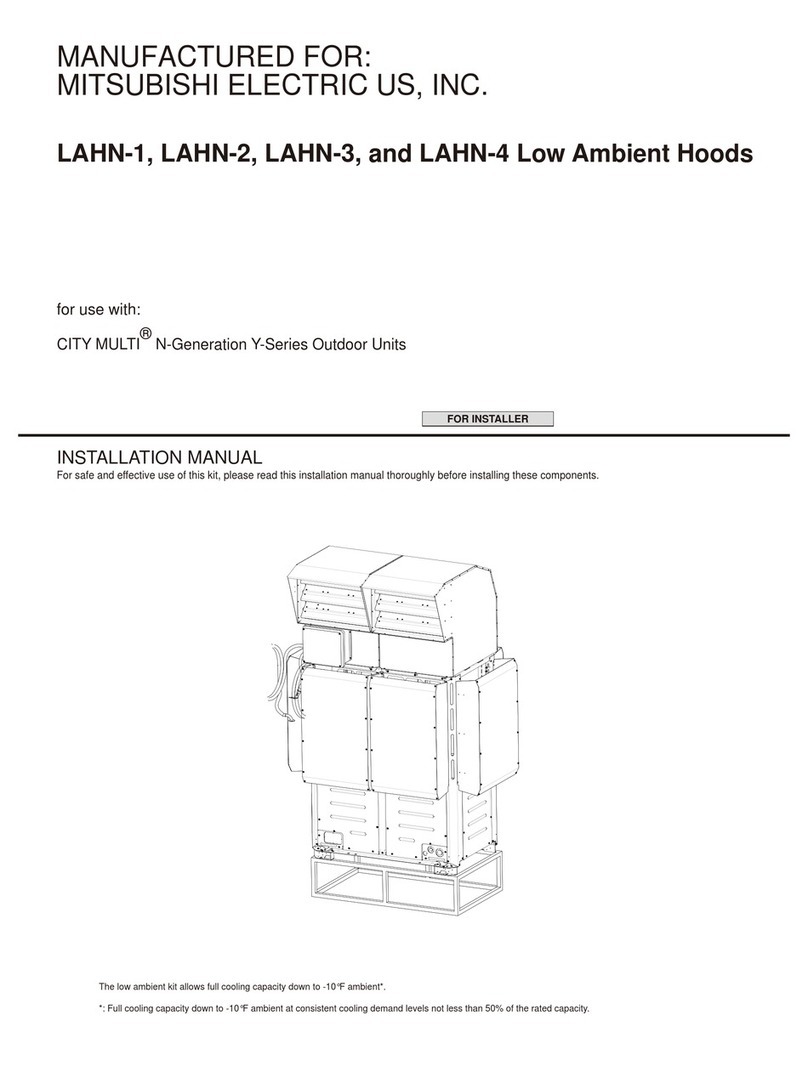
4
Specications are subject to change without notice. © 2019 Mitsubishi Electric US, Inc.
Circuit board
Conrm the thermistor is operating properly before troubleshooting
the circuit board.
Make sure the control board has 24 Volts AC when measured at the
24 VAC and the com terminals. If not, nd the cause of voltage failure.
The circuit board is designed to convert the thermistor ohm input to
a 2 - 9.16 VDC output to control the position of the damper actuator.
Above 2 VDC output the actuator will start to move the damper toward
the closed position. At 9.16 VDC, the actuator will have moved 85
degrees and the damper will be approximately 95% closed. The
damper should never be 100% closed. The chart below includes the
various damper angles based on the different outdoor temperatures.
Measure the DC voltage output on the circuit board at com (-) and
the out (+) terminals. If the output doesn’t match the thermistor input
ohms as shown below, replace the circuit board.
Ambient Temp Hood Angle Output Voltage Resistance
[ °F ] [ ° ] vΩ
-10 80 8.78 117960
-5 80 8.78 100184
0 70 7.9 85340
570 7.9 72906
10 70 7.9 62460
15 70 7.9 53658
20 60 7.04 46220
25 60 7.04 39917
30 60 7.04 34562
35 60 7.04 30000
40 OPEN 226104
45 OPEN 222767
Transformer
The transformer is 208/230 – 24 volt AC. For proper connections to
the outdoor unit, refer to the following diagram and instructions.
The transformer is 208/230 – 24volt AC. For proper
connections to the outdoor unit, the following diagram
and instructions should be referred to.
The low ambient kit is designed to function with both
208/230 volt and also 460 volt outdoor units.
On 208 volt units the CNAC2 connector will provide
208 volts to the control transformer.
On 230 volt units the CNAC2 connector will provide
230 volts to the control transformer.
The 460 volt units include a transformer that reduces
the outdoor unit internal voltage to 230 volts. Because
of this, on the 460 volt units the CNAC2 connector will
also provide 230 volts to the control transformer.
Once the proper connection is confirmed, measure
voltage on the primary side of the transformer. It
should be 208 or 230 +- 10% depending on the supply
voltage at the outdoor unit. If there is no voltage on the
primary side of the transformer check the fuse that is
located in the fuse holder inside the outdoor unit. See
wiring diagram for fuse location. Once power has been
confirmed at the primary side of the transformer, check
the secondary/low voltage side of the transformer it
should be approximately 27 volts. If no voltage is
present, replace transformer.
Interlock Relay
The interlock relay uses a normally closed contact to
allow power to flow to the transformer energizing the
low ambient kit control circuitry. Any time the outdoor
unit is in cooling mode, this contact will be in closed.
When the outdoor unit reversing valves energizes
(switches to heating mode) the coil of the relay is
energized, opening this contact. This in-turn de-
energizes the transformer, disconnecting power to the
low ambient kit control circuitry. This allows the damper
to spring return to the full open position during heating
mode.
To check, make sure the contact is closed when the
outdoor unit is in cooling mode (coil de-energized) and
the contact is open when the outdoor unit is in the
heating mode (coil energized).
Damper Actuator
Before trouble shooting the damper motor, verify the
two factory switches are in the position shown below.
Make sure the motor has 24 volts on the (1) Common
and(2) +Hot connections. If not, find the cause of the
voltage failure and correct.
The damper actuator receives a DC voltage signal
from the circuit board. This voltage can be measured
between (1) Common and (3) 2-10VDC connections.
The damper actuator has an angle indicator where it
clamps onto the damper shaft linkage.
Compare the DC voltage supply to the damper angle
indicator position in the chart below. The angle should
be within 2% of the chart shown below. If not, check to
make sure the damper started off in the correct
position. 0 Degrees
IMPORTANT!
It’s possible that during shipping, the damper shaft
may have moved in the actuator shaft clamp
assembly. With power off, make sure the damper is
in the full open position. 0 degrees If necessary,
loosen the shaft clamp on the actuator, move the
damper to the 100% open position, and re-clamp
tightly.
If the damper actuator angle doesn’t match within 2%,
with the corresponding control board voltage supplied
as shown below, the damper actuator should be
replaced.
OutdoorThermistor Control board Damper
Temperature Ohms DC volts output Angle
Above 52
o
FN/A 2.00 0
o
full open
o
December 2013
© 2013 Mitsubishi Electric US, Inc. 4
The low ambient kit is designed to function with both 208/230 volt
and also 460 volt outdoor units.
On 208 volt units the CNAC2 connector will provide 208 volts to the
control transformer.
On 230 volt units the CNAC2 connector will provide 230 volts to the
control transformer.
The 460 volt units include a transformer that reduces the outdoor
unit internal voltage to 230 volts. Because of this, on the 460 volt
units the CNAC2 connector will also provide 230 volts to the control
transformer.
Once the proper connection is conrmed, measure voltage on the
primary side of the transformer. It should be 208 or 230 +- 10%
depending on the supply voltage at the outdoor unit. If there is no
voltage on the primary side of the transformer, check the fuse that
is located in the fuse holder inside the outdoor unit. See the wiring
diagram for fuse location. Once power has been conrmed at the
primary side of the transformer, check the secondary/low voltage
side of the transformer. It should be approximately 27 volts. If no
voltage is present, replace the transformer.
Interlock relay
The interlock relay uses a normally closed contact to allow power to
ow to the transformer energizing the low ambient kit control circuitry.
Any time the outdoor unit is in cooling mode, this contact will be in
closed. When the outdoor unit reversing valves energizes (switches to
heating mode) the coil of the relay is energized, opening this contact.
This in turn de-energizes the transformer, disconnecting power to
the low ambient kit control circuitry. This allows the damper to spring
return to the full open position during heating mode.
To check, make sure the contact is closed when the outdoor unit is in
cooling mode (coil de-energized) and the contact is open when the
outdoor unit is in the heating mode (coil energized).
Damper actuator
Before trouble shooting the damper motor, verify the two factory
switches are in the position shown below.
The transformer is 208/230 – 24volt AC. For proper
connections to the outdoor unit, the following diagram
and instructions should be referred to.
The low ambient kit is designed to function with both
208/230 volt and also 460 volt outdoor units.
On 208 volt units the CNAC2 connector will provide
208 volts to the control transformer.
On 230 volt units the CNAC2 connector will provide
230 volts to the control transformer.
The 460 volt units include a transformer that reduces
the outdoor unit internal voltage to 230 volts. Because
of this, on the 460 volt units the CNAC2 connector will
also provide 230 volts to the control transformer.
Once the proper connection is confirmed, measure
voltage on the primary side of the transformer. It
should be 208 or 230 +- 10% depending on the supply
voltage at the outdoor unit. If there is no voltage on the
primary side of the transformer check the fuse that is
located in the fuse holder inside the outdoor unit. See
wiring diagram for fuse location. Once power has been
confirmed at the primary side of the transformer, check
the secondary/low voltage side of the transformer it
should be approximately 27 volts. If no voltage is
present, replace transformer.
Interlock Relay
The interlock relay uses a normally closed contact to
allow power to flow to the transformer energizing the
low ambient kit control circuitry. Any time the outdoor
unit is in cooling mode, this contact will be in closed.
When the outdoor unit reversing valves energizes
(switches to heating mode) the coil of the relay is
energized, opening this contact. This in-turn de-
energizes the transformer, disconnecting power to the
low ambient kit control circuitry. This allows the damper
to spring return to the full open position during heating
mode.
To check, make sure the contact is closed when the
outdoor unit is in cooling mode (coil de-energized) and
the contact is open when the outdoor unit is in the
heating mode (coil energized).
Damper Actuator
Before trouble shooting the damper motor, verify the
two factory switches are in the position shown below.
(2) + Hot
(3) 2-10VDC
(5)
Make sure the motor has 24 volts on the (1) Common
and(2) +Hot connections. If not, find the cause of the
voltage failure and correct.
The damper actuator receives a DC voltage signal
from the circuit board. This voltage can be measured
between (1) Common and (3) 2-10VDC connections.
The damper actuator has an angle indicator where it
clamps onto the damper shaft linkage.
Compare the DC voltage supply to the damper angle
indicator position in the chart below. The angle should
be within 2% of the chart shown below. If not, check to
make sure the damper started off in the correct
position. 0 Degrees
IMPORTANT!
It’s possible that during shipping, the damper shaft
may have moved in the actuator shaft clamp
assembly. With power off, make sure the damper is
in the full open position. 0 degrees If necessary,
loosen the shaft clamp on the actuator, move the
damper to the 100% open position, and re-clamp
tightly.
If the damper actuator angle doesn’t match within 2%,
with the corresponding control board voltage supplied
as shown below, the damper actuator should be
replaced.
OutdoorThermistor Control board Damper
Temperature Ohms DC volts output Angle
Above 52
o
FN/A 2.00 0
o
full open
o
December 2013
© 2013 Mitsubishi Electric US, Inc. 4
Make sure the motor has 24 volts on the (1) Common and (2) +Hot
connections. If not, nd the cause of the voltage failure and correct.
The damper actuator receives a DC voltage signal from the circuit
board. This voltage can be measured between (1) Common and (3)
2-10VDC connections.
The damper actuator has an angle indicator where it clamps onto the
damper shaft linkage.
Compare the DC voltage supply to the damper angle indicator position
in the chart below. The angle should be within 2% of the chart shown
below. If not, check to make sure the damper started off in the correct
position, 0 Degrees.
IMPORTANT!
It’s possible that during shipping, the damper shaft may have
moved in the actuator shaft clamp assembly. See Section 3.
Damper Blade Adjustment.
If the damper actuator angle doesn’t match within 2%, with the
corresponding control board voltage supplied as shown below, the
damper actuator should be replaced.
Ambient Temp Hood Angle Output Voltage Resistance
[ °F ] [ ° ] vΩ
-10 80 8.78 117960
-5 80 8.78 100184
0 70 7.9 85340
570 7.9 72906
10 70 7.9 62460
15 70 7.9 53658
20 60 7.04 46220
25 60 7.04 39917
30 60 7.04 34562
35 60 7.04 30000
40 OPEN 226104
45 OPEN 222767





































